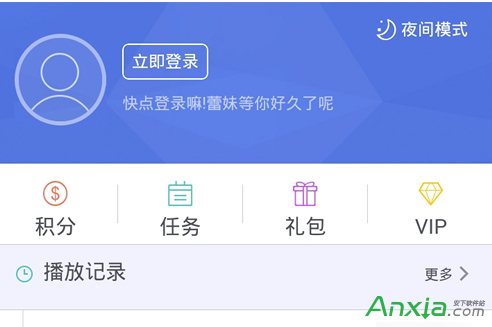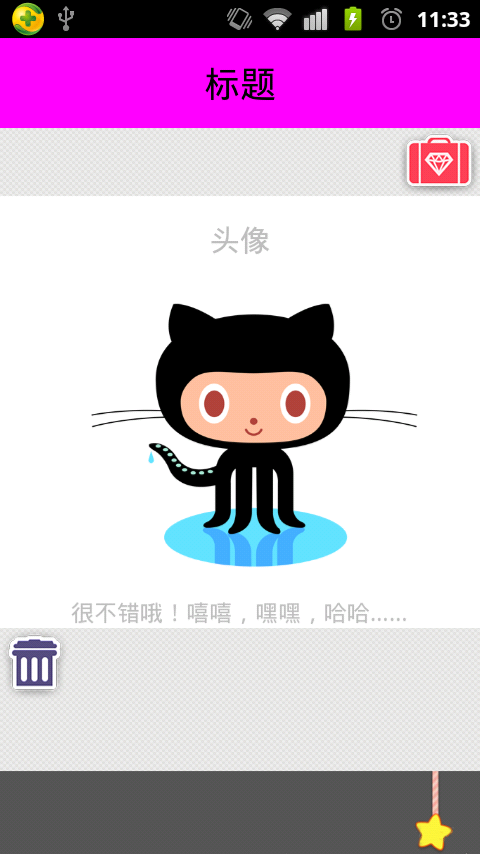編輯:關於Android編程
本文實例總結了Android編程之內存溢出解決方案(OOM)。分享給大家供大家參考,具體如下:
在最近做的工程中發現加載的圖片太多或圖片過大時經常出現OOM問題,找網上資料也提供了很多方法,但自己感覺有點亂,特此,今天在不同型號的三款安卓手機上做了測試,因為有效果也有結果,今天小馬就做個詳細的總結,以供朋友們共同交流學習,也供自己以後在解決OOM問題上有所提高,提前講下,片幅有點長,涉及的東西太多,大家耐心看,肯定有收獲的,裡面的很多東西小馬也是學習參考網絡資料使用的,先來簡單講下下:
一般我們大家在遇到內存問題的時候常用的方式網上也有相關資料,大體如下幾種:
一:在內存引用上做些處理,常用的有軟引用、強化引用、弱引用
二:在內存中加載圖片時直接在內存中做處理,如:邊界壓縮
三:動態回收內存
四:優化Dalvik虛擬機的堆內存分配
五:自定義堆內存大小
可是真的有這麼簡單嗎,就用以上方式就能解決OOM了?不是的,繼續來看...
下面小馬就照著上面的次序來整理下解決的幾種方式,數字序號與上面對應:
1:軟引用(SoftReference)、虛引用(PhantomRefrence)、弱引用(WeakReference),這三個類是對heap中java對象的應用,通過這個三個類可以和gc做簡單的交互,除了這三個以外還有一個是最常用的強引用
1.1:強引用,例如下面代碼:
Object o=new Object(); Object o1=o;
上面代碼中第一句是在heap堆中創建新的Object對象通過o引用這個對象,第二句是通過o建立o1到new Object()這個heap堆中的對象的引用,這兩個引用都是強引用.只要存在對heap中對象的引用,gc就不會收集該對象.如果通過如下代碼:
o=null; o1=null
heap中對象有強可及對象、軟可及對象、弱可及對象、虛可及對象和不可到達對象。應用的強弱順序是強、軟、弱、和虛。對於對象是屬於哪種可及的對象,由他的最強的引用決定。如下:
String abc=new String("abc"); //1
SoftReference<String> abcSoftRef=new SoftReference<String>(abc); //2
WeakReference<String> abcWeakRef = new WeakReference<String>(abc); //3
abc=null; //4
abcSoftRef.clear();//5
上面的代碼中:
第一行在heap對中創建內容為“abc”的對象,並建立abc到該對象的強引用,該對象是強可及的。第二行和第三行分別建立對heap中對象的軟引用和弱引用,此時heap中的對象仍是強可及的。第四行之後heap中對象不再是強可及的,變成軟可及的。同樣第五行執行之後變成弱可及的。
1.2:軟引用
軟引用是主要用於內存敏感的高速緩存。在jvm報告內存不足之前會清除所有的軟引用,這樣以來gc就有可能收集軟可及的對象,可能解決內存吃緊問題,避免內存溢出。什麼時候會被收集取決於gc的算法和gc運行時可用內存的大小。當gc決定要收集軟引用是執行以下過程,以上面的abcSoftRef為例:
1 首先將abcSoftRef的referent設置為null,不再引用heap中的new String("abc")對象。
2 將heap中的new String("abc")對象設置為可結束的(finalizable)。
3 當heap中的new String("abc")對象的finalize()方法被運行而且該對象占用的內存被釋放, abcSoftRef被添加到它的ReferenceQueue中。
注:對ReferenceQueue軟引用和弱引用可以有可無,但是虛引用必須有,參見:
Reference(T paramT, ReferenceQueue<? super T>paramReferenceQueue)
被 Soft Reference 指到的對象,即使沒有任何 Direct Reference,也不會被清除。一直要到 JVM 內存不足且 沒有 Direct Reference 時才會清除,SoftReference 是用來設計 object-cache 之用的。如此一來 SoftReference 不但可以把對象 cache 起來,也不會造成內存不足的錯誤 (OutOfMemoryError)。我覺得 Soft Reference 也適合拿來實作 pooling 的技巧。
A obj = new A();
Refenrence sr = new SoftReference(obj);
//引用時
if(sr!=null){
obj = sr.get();
}else{
obj = new A();
sr = new SoftReference(obj);
}
1.3:弱引用
當gc碰到弱可及對象,並釋放abcWeakRef的引用,收集該對象。但是gc可能需要對此運用才能找到該弱可及對象。通過如下代碼可以了明了的看出它的作用:
String abc=new String("abc");
WeakReference<String> abcWeakRef = new WeakReference<String>(abc);
abc=null;
System.out.println("before gc: "+abcWeakRef.get());
System.gc();
System.out.println("after gc: "+abcWeakRef.get());
運行結果:
before gc: abc
after gc: null
gc收集弱可及對象的執行過程和軟可及一樣,只是gc不會根據內存情況來決定是不是收集該對象。如果你希望能隨時取得某對象的信息,但又不想影響此對象的垃圾收集,那麼你應該用 Weak Reference 來記住此對象,而不是用一般的 reference。
A obj = new A();
WeakReference wr = new WeakReference(obj);
obj = null;
//等待一段時間,obj對象就會被垃圾回收
...
if (wr.get()==null) {
System.out.println("obj 已經被清除了 ");
} else {
System.out.println("obj 尚未被清除,其信息是 "+obj.toString());
}
...
}
在此例中,透過 get() 可以取得此 Reference 的所指到的對象,如果返回值為 null 的話,代表此對象已經被清除。這類的技巧,在設計 Optimizer 或 Debugger 這類的程序時常會用到,因為這類程序需要取得某對象的信息,但是不可以 影響此對象的垃圾收集。
1.4:虛引用
就是沒有的意思,建立虛引用之後通過get方法返回結果始終為null,通過源代碼你會發現,虛引用通向會把引用的對象寫進referent,只是get方法返回結果為null.先看一下和gc交互的過程在說一下他的作用.
1.4.1 不把referent設置為null, 直接把heap中的new String("abc")對象設置為可結束的(finalizable).
1.4.2 與軟引用和弱引用不同, 先把PhantomRefrence對象添加到它的ReferenceQueue中.然後在釋放虛可及的對象.
你會發現在收集heap中的new String("abc")對象之前,你就可以做一些其他的事情.通過以下代碼可以了解他的作用.
import java.lang.ref.PhantomReference;
import java.lang.ref.Reference;
import java.lang.ref.ReferenceQueue;
import java.lang.reflect.Field;
public class Test {
public static boolean isRun = true;
public static void main(String[] args) throws Exception {
String abc = new String("abc");
System.out.println(abc.getClass() + "@" + abc.hashCode());
final ReferenceQueue referenceQueue = new ReferenceQueue<String>();
new Thread() {
public void run() {
while (isRun) {
Object o = referenceQueue.poll();
if (o != null) {
try {
Field rereferent = Reference.class
.getDeclaredField("referent");
rereferent.setAccessible(true);
Object result = rereferent.get(o);
System.out.println("gc will collect:"
+ result.getClass() + "@"
+ result.hashCode());
} catch (Exception e) {
e.printStackTrace();
}
}
}
}
}.start();
PhantomReference<String> abcWeakRef = new PhantomReference<String>(abc,
referenceQueue);
abc = null;
Thread.currentThread().sleep(3000);
System.gc();
Thread.currentThread().sleep(3000);
isRun = false;
}
}
結果為
class java.lang.String@96354
gc will collect:class java.lang.String@96354
好了,關於引用就講到這,下面看2
2:在內存中壓縮小馬做了下測試,對於少量不太大的圖片這種方式可行,但太多而又大的圖片小馬用個笨的方式就是,先在內存中壓縮,再用軟引用避免OOM,兩種方式代碼如下,大家可參考下:
方式一代碼如下:
@SuppressWarnings("unused")
private Bitmap copressImage(String imgPath){
File picture = new File(imgPath);
Options bitmapFactoryOptions = new BitmapFactory.Options();
//下面這個設置是將圖片邊界不可調節變為可調節
bitmapFactoryOptions.inJustDecodeBounds = true;
bitmapFactoryOptions.inSampleSize = 2;
int outWidth = bitmapFactoryOptions.outWidth;
int outHeight = bitmapFactoryOptions.outHeight;
bmap = BitmapFactory.decodeFile(picture.getAbsolutePath(),
bitmapFactoryOptions);
float imagew = 150;
float imageh = 150;
int yRatio = (int) Math.ceil(bitmapFactoryOptions.outHeight
/ imageh);
int xRatio = (int) Math
.ceil(bitmapFactoryOptions.outWidth / imagew);
if (yRatio > 1 || xRatio > 1) {
if (yRatio > xRatio) {
bitmapFactoryOptions.inSampleSize = yRatio;
} else {
bitmapFactoryOptions.inSampleSize = xRatio;
}
}
bitmapFactoryOptions.inJustDecodeBounds = false;
bmap = BitmapFactory.decodeFile(picture.getAbsolutePath(),
bitmapFactoryOptions);
if(bmap != null){
//ivwCouponImage.setImageBitmap(bmap);
return bmap;
}
return null;
}
方式二代碼如下:
package com.lvguo.scanstreet.activity;
import java.io.File;
import java.lang.ref.SoftReference;
import java.util.ArrayList;
import java.util.HashMap;
import java.util.List;
import android.app.Activity;
import android.app.AlertDialog;
import android.content.Context;
import android.content.DialogInterface;
import android.content.Intent;
import android.content.res.TypedArray;
import android.graphics.Bitmap;
import android.graphics.BitmapFactory;
import android.graphics.BitmapFactory.Options;
import android.os.Bundle;
import android.view.View;
import android.view.ViewGroup;
import android.view.WindowManager;
import android.widget.AdapterView;
import android.widget.AdapterView.OnItemLongClickListener;
import android.widget.BaseAdapter;
import android.widget.Gallery;
import android.widget.ImageView;
import android.widget.Toast;
import com.lvguo.scanstreet.R;
import com.lvguo.scanstreet.data.ApplicationData;
/**
* @Title: PhotoScanActivity.java
* @Description: 照片預覽控制類
* @author XiaoMa
*/
public class PhotoScanActivity extends Activity {
private Gallery gallery ;
private List<String> ImageList;
private List<String> it ;
private ImageAdapter adapter ;
private String path ;
private String shopType;
private HashMap<String, SoftReference<Bitmap>> imageCache = null;
private Bitmap bitmap = null;
private SoftReference<Bitmap> srf = null;
@Override
public void onCreate(Bundle savedInstanceState) {
super.onCreate(savedInstanceState);
getWindow().setFlags(WindowManager.LayoutParams.FLAG_FULLSCREEN,
WindowManager.LayoutParams.FLAG_FULLSCREEN);
setContentView(R.layout.photoscan);
Intent intent = this.getIntent();
if(intent != null){
if(intent.getBundleExtra("bundle") != null){
Bundle bundle = intent.getBundleExtra("bundle");
path = bundle.getString("path");
shopType = bundle.getString("shopType");
}
}
init();
}
private void init(){
imageCache = new HashMap<String, SoftReference<Bitmap>>();
gallery = (Gallery)findViewById(R.id.gallery);
ImageList = getSD();
if(ImageList.size() == 0){
Toast.makeText(getApplicationContext(), "無照片,請返回拍照後再使用預覽", Toast.LENGTH_SHORT).show();
return ;
}
adapter = new ImageAdapter(this, ImageList);
gallery.setAdapter(adapter);
gallery.setOnItemLongClickListener(longlistener);
}
/**
* Gallery長按事件操作實現
*/
private OnItemLongClickListener longlistener = new OnItemLongClickListener() {
@Override
public boolean onItemLongClick(AdapterView<?> parent, View view,
final int position, long id) {
//此處添加長按事件刪除照片實現
AlertDialog.Builder dialog = new AlertDialog.Builder(PhotoScanActivity.this);
dialog.setIcon(R.drawable.warn);
dialog.setTitle("刪除提示");
dialog.setMessage("你確定要刪除這張照片嗎?");
dialog.setPositiveButton("確定", new DialogInterface.OnClickListener() {
@Override
public void onClick(DialogInterface dialog, int which) {
File file = new File(it.get(position));
boolean isSuccess;
if(file.exists()){
isSuccess = file.delete();
if(isSuccess){
ImageList.remove(position);
adapter.notifyDataSetChanged();
//gallery.setAdapter(adapter);
if(ImageList.size() == 0){
Toast.makeText(getApplicationContext(), getResources().getString(R.string.phoSizeZero), Toast.LENGTH_SHORT).show();
}
Toast.makeText(getApplicationContext(), getResources().getString(R.string.phoDelSuccess), Toast.LENGTH_SHORT).show();
}
}
}
});
dialog.setNegativeButton("取消",new DialogInterface.OnClickListener() {
@Override
public void onClick(DialogInterface dialog, int which) {
dialog.dismiss();
}
});
dialog.create().show();
return false;
}
};
/**
* 獲取SD卡上的所有圖片文件
* @return
*/
private List<String> getSD() {
/* 設定目前所在路徑 */
File fileK ;
it = new ArrayList<String>();
if("newadd".equals(shopType)){
//如果是從查看本人新增列表項或商戶列表項進來時
fileK = new File(ApplicationData.TEMP);
}else{
//此時為純粹新增
fileK = new File(path);
}
File[] files = fileK.listFiles();
if(files != null && files.length>0){
for(File f : files ){
if(getImageFile(f.getName())){
it.add(f.getPath());
Options bitmapFactoryOptions = new BitmapFactory.Options();
//下面這個設置是將圖片邊界不可調節變為可調節
bitmapFactoryOptions.inJustDecodeBounds = true;
bitmapFactoryOptions.inSampleSize = 5;
int outWidth = bitmapFactoryOptions.outWidth;
int outHeight = bitmapFactoryOptions.outHeight;
float imagew = 150;
float imageh = 150;
int yRatio = (int) Math.ceil(bitmapFactoryOptions.outHeight
/ imageh);
int xRatio = (int) Math
.ceil(bitmapFactoryOptions.outWidth / imagew);
if (yRatio > 1 || xRatio > 1) {
if (yRatio > xRatio) {
bitmapFactoryOptions.inSampleSize = yRatio;
} else {
bitmapFactoryOptions.inSampleSize = xRatio;
}
}
bitmapFactoryOptions.inJustDecodeBounds = false;
bitmap = BitmapFactory.decodeFile(f.getPath(),
bitmapFactoryOptions);
//bitmap = BitmapFactory.decodeFile(f.getPath());
srf = new SoftReference<Bitmap>(bitmap);
imageCache.put(f.getName(), srf);
}
}
}
return it;
}
/**
* 獲取圖片文件方法的具體實現
* @param fName
* @return
*/
private boolean getImageFile(String fName) {
boolean re;
/* 取得擴展名 */
String end = fName
.substring(fName.lastIndexOf(".") + 1, fName.length())
.toLowerCase();
/* 按擴展名的類型決定MimeType */
if (end.equals("jpg") || end.equals("gif") || end.equals("png")
|| end.equals("jpeg") || end.equals("bmp")) {
re = true;
} else {
re = false;
}
return re;
}
public class ImageAdapter extends BaseAdapter{
/* 聲明變量 */
int mGalleryItemBackground;
private Context mContext;
private List<String> lis;
/* ImageAdapter的構造符 */
public ImageAdapter(Context c, List<String> li) {
mContext = c;
lis = li;
TypedArray a = obtainStyledAttributes(R.styleable.Gallery);
mGalleryItemBackground = a.getResourceId(R.styleable.Gallery_android_galleryItemBackground, 0);
a.recycle();
}
/* 幾定要重寫的方法getCount,傳回圖片數目 */
public int getCount() {
return lis.size();
}
/* 一定要重寫的方法getItem,傳回position */
public Object getItem(int position) {
return lis.get(position);
}
/* 一定要重寫的方法getItemId,傳並position */
public long getItemId(int position) {
return position;
}
/* 幾定要重寫的方法getView,傳並幾View對象 */
public View getView(int position, View convertView, ViewGroup parent) {
System.out.println("lis:"+lis);
File file = new File(it.get(position));
SoftReference<Bitmap> srf = imageCache.get(file.getName());
Bitmap bit = srf.get();
ImageView i = new ImageView(mContext);
i.setImageBitmap(bit);
i.setScaleType(ImageView.ScaleType.FIT_XY);
i.setLayoutParams( new Gallery.LayoutParams(WindowManager.LayoutParams.WRAP_CONTENT,
WindowManager.LayoutParams.WRAP_CONTENT));
return i;
}
}
}
上面兩種方式第一種直接使用邊界壓縮,第二種在使用邊界壓縮的情況下間接的使用了軟引用來避免OOM,但大家都知道,這些函數在完成decode後,最終都是通過java層的createBitmap來完成的,需要消耗更多內存,如果圖片多且大,這種方式還是會引用OOM異常的,不著急,有的是辦法解決,繼續看,以下方式也大有妙用的:
1.
InputStream is = this.getResources().openRawResource(R.drawable.pic1); BitmapFactory.Options options=new BitmapFactory.Options(); options.inJustDecodeBounds = false; options.inSampleSize = 10; //width,hight設為原來的十分一 Bitmap btp =BitmapFactory.decodeStream(is,null,options);
2.
if(!bmp.isRecycle() ){
bmp.recycle() //回收圖片所占的內存
system.gc() //提醒系統及時回收
}
上面代碼與下面代碼大家可分開使用,也可有效緩解內存問題哦...吼吼...
/** 這個地方大家別搞混了,為了方便小馬把兩個貼一起了,使用的時候記得分開使用
* 以最省內存的方式讀取本地資源的圖片
*/
public static Bitmap readBitMap(Context context, int resId){
BitmapFactory.Options opt = new BitmapFactory.Options();
opt.inPreferredConfig = Bitmap.Config.RGB_565;
opt.inPurgeable = true;
opt.inInputShareable = true;
//獲取資源圖片
InputStream is = context.getResources().openRawResource(resId);
return BitmapFactory.decodeStream(is,null,opt);
}
3:大家可以選擇在合適的地方使用以下代碼動態並自行顯式調用GC來回收內存:
if(bitmapObject.isRecycled()==false) //如果沒有回收
bitmapObject.recycle();
4:這個就好玩了,優化Dalvik虛擬機的堆內存分配,聽著很強大,來看下具體是怎麼一回事
對於Android平台來說,其托管層使用的Dalvik JavaVM從目前的表現來看還有很多地方可以優化處理,比如我們在開發一些大型游戲或耗資源的應用中可能考慮手動干涉GC處理,使用 dalvik.system.VMRuntime類提供的setTargetHeapUtilization方法可以增強程序堆內存的處理效率。當然具體原理我們可以參考開源工程,這裡我們僅說下使用方法: 代碼如下:
復制代碼 代碼如下:private final static floatTARGET_HEAP_UTILIZATION = 0.75f;
在程序onCreate時就可以調用
復制代碼 代碼如下:VMRuntime.getRuntime().setTargetHeapUtilization(TARGET_HEAP_UTILIZATION);
即可
5:自定義我們的應用需要多大的內存,這個好暴力哇,強行設置最小內存大小,代碼如下:
private final static int CWJ_HEAP_SIZE = 6* 1024* 1024 ; //設置最小heap內存為6MB大小 VMRuntime.getRuntime().setMinimumHeapSize(CWJ_HEAP_SIZE);
好了,文章寫完了,片幅有點長,因為涉及到的東西太多了,其它文章小馬都會貼源碼,這篇文章小馬是直接在項目中用三款安卓真機測試的,有效果,項目原碼就不在這貼了,不然洩密了都,吼吼,但這裡講下還是會因為手機的不同而不同,大家得根據自己需求選擇合適的方式來避免OOM,大家加油呀,每天都有或多或少的收獲,這也算是進步,加油加油!
希望本文所述對大家Android程序設計有所幫助。
 手機迅雷個人中心關閉朋友圈方法
手機迅雷個人中心關閉朋友圈方法
1、打開手機迅雷點擊切換到我的迅雷個人中心,點擊左上角[登錄],已登錄請跳過2、在手機迅雷個人中心的最下面,倒數第二項[常用設置]點擊進行設置3、繼續在常用
 Android中ViewFlipper的使用及設置動畫效果實例詳解
Android中ViewFlipper的使用及設置動畫效果實例詳解
本文實例講述了Android中ViewFlipper的使用及設置動畫效果。分享給大家供大家參考,具體如下:說到左右滑動,其實實現左右滑動的方式很多,有ViewPaer,自
 android NDK環境搭建
android NDK環境搭建
由於Linux系統的權限限制和Android封裝架構限制,很多涉及底層設備、接口、驅動控制的應用開發,不得不使用到本文的NDK開發環境(基於Android源碼或內核源碼修
 Android 做一款直播APP?一分鐘掌握樂視雲直播Demo
Android 做一款直播APP?一分鐘掌握樂視雲直播Demo
最近工作需要做一款直播APP,恩是的,從RTMP協議的實現開始到處理服務器高並發、負載均衡、客戶端播放器實現等等等.....估計全部寫完我也到而立之年了吧23333...